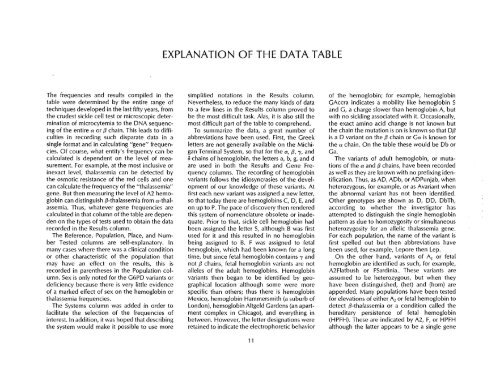SCOOTER82a_Livingstone_Frequencies of Hemoglobin Variants ...
SCOOTER82a_Livingstone_Frequencies of Hemoglobin Variants ...
SCOOTER82a_Livingstone_Frequencies of Hemoglobin Variants ...
You also want an ePaper? Increase the reach of your titles
YUMPU automatically turns print PDFs into web optimized ePapers that Google loves.
The frequencies and results compiled in the<br />
table were determined by the entire range <strong>of</strong><br />
techniques developed in the last fifty years, from<br />
the crudest sickle cell test or microscopic determination<br />
<strong>of</strong> microcytemia to the DNA sequencing<br />
<strong>of</strong> the entire a or (3 chain. This leads to difficulties<br />
in recording such disparate data in a<br />
single format and in calculating "gene" frequencies.<br />
Of course, what entity's frequency can be<br />
calculated is dependent on the level <strong>of</strong> measurement.<br />
For example, at the most inclusive or<br />
inexact level, thalassemia can be detected by<br />
the osmotic resistance <strong>of</strong> the red cells and one<br />
can calculate the frequency <strong>of</strong> the "thalassemia"<br />
gene. But then measuring the level <strong>of</strong> A2 hemoglobin<br />
can distinguish (3-thalassemia from a-thalassemia.<br />
Thus, whatever gene frequencies are<br />
calculated in that column <strong>of</strong> the table are dependen<br />
on the types <strong>of</strong> tests used to obtain the data<br />
recorded in the Results column.<br />
The Reference, Population, Place, and Number<br />
Tested columns are self-explanatory. In<br />
many cases where there was a clinical condition<br />
or other characteristic <strong>of</strong> the population that<br />
may have an effect on the results, this is<br />
recorded in parentheses in the Population column.<br />
Sex is only noted for the G6PD variants or<br />
deficiency because there is very little evidence<br />
<strong>of</strong> a marked effect <strong>of</strong> sex on the hemoglobin or<br />
thalassemia frequencies.<br />
The Systems column was added in order to<br />
facilitate the selection <strong>of</strong> the frequencies <strong>of</strong><br />
interest. In addition, it was hoped that describing<br />
the system would make it possible to use more<br />
EXPLANATION OF THE DATA TABLE<br />
simplified notations in the Results column.<br />
Nevertheless, to reduce the many kinds <strong>of</strong> data<br />
to a few lines in the Results column proved to<br />
be the most difficult task. Alas, it is also still the<br />
most difficult part <strong>of</strong> the table to comprehend.<br />
To summarize the data, a great number <strong>of</strong><br />
abbreviations have been used. First, the Greek<br />
letters are not generally available on the Michigan<br />
Terminal System, so that for the a, (3, 'Y, and<br />
ochains <strong>of</strong> hemoglobin, the letters a, b, g, and d<br />
are used in both the Results and Gene Frequency<br />
columns. The recording <strong>of</strong> hemoglobin<br />
variants follows the idiosyncrasies <strong>of</strong> the development<br />
<strong>of</strong> our knowledge <strong>of</strong> these variants. At<br />
first each new variant was assigned a new letter,<br />
so that today there are hemoglobins C, D, E, and<br />
on upto P. The pace <strong>of</strong> discovery then rendered<br />
this system <strong>of</strong> nomenclature obsolete or inadequate.<br />
Prior to that, sickle cell hemoglobin had<br />
been assigned the letter S, although B was first<br />
used for it and this resulted in no hemoglobin<br />
being assigned to B. F was assigned to fetal<br />
hemoglobin, which had been known for a long<br />
time, but since fetal hemoglobin contains 'Y and<br />
not (3 chains, fetal hemoglobin variants are not<br />
alleles <strong>of</strong> the adult hemoglobins. <strong>Hemoglobin</strong><br />
variants then began to be identified by geographical<br />
location although some were more<br />
specific than others; thus there is hemoglobin<br />
Mexico, hemoglobin Hammersmith (a suburb <strong>of</strong><br />
London), hemoglobin Altgeld Gardens (an apartment<br />
complex in Chicago), and everything in<br />
between. However, the letter designations were<br />
retained to indicate the electrophoretic behavior<br />
11<br />
<strong>of</strong> the hemoglobin; for example, hemoglobin<br />
GAccra indicates a mobility like hemoglobin S<br />
and G, a charge slower than hemoglobin A, but<br />
with no sickling associated with it. Occasionally,<br />
the exact amino acid change is not known but<br />
the chain the mutation is on is known so that D(3<br />
is a D variant on the (3 chain or Ga is known for<br />
the a chain. On the table these would be Db or<br />
Ga.<br />
The variants <strong>of</strong> adult hemoglobin, or mutations<br />
<strong>of</strong> the a and (3 chains, have been recorded<br />
as well as they are known with no prefixing identification.<br />
Thus, asAD, ADb, or ADPunjab, when<br />
heterozygous, for example, or as Avariant when<br />
the abnormal variant has not been identified.<br />
Other genotypes are shown as D, DD, DbTh,<br />
according to whether the investigator has<br />
attempted to distinguish the single hemoglobin<br />
pattern as due to homozygosity or simultaneous<br />
heterozygosity for an allelic thalassemia gene.<br />
For each population, the name <strong>of</strong> the variant is<br />
first spelled out but then abbreviations have<br />
been used, for example, Lepore then Lep.<br />
On the other hand, variants <strong>of</strong> A 2 or fetal<br />
hemoglobin are identified as such, for example,<br />
A2 Flatbush or FSardinia. These variants are<br />
assumed to be heterozygous, but when they<br />
have been distinguished, (het) and (hom) are<br />
appended. Many populations have been tested<br />
for elevations <strong>of</strong> either A 2 or fetal hemoglobin to<br />
detect (3-thalassemia or a condition called the<br />
hereditary persistence <strong>of</strong> fetal hemoglobin<br />
(HPFH). These are indicated by A2, F, or HPFH<br />
although the latter appears to be a single gene


